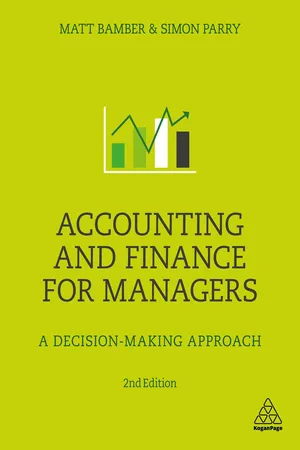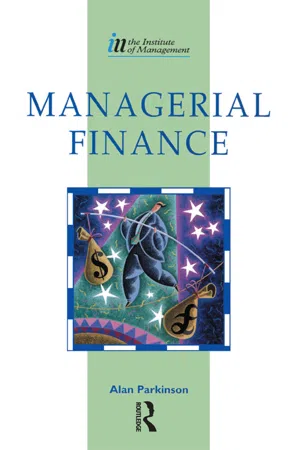Business
NPV Investment Decision Rule
The NPV (Net Present Value) investment decision rule is a financial metric used to evaluate the profitability of an investment. It compares the present value of expected cash flows from an investment to the initial cost of the investment. If the NPV is positive, the investment is considered financially viable, while a negative NPV suggests the investment may not be worthwhile.
Written by Perlego with AI-assistance
Related key terms
Related key terms
1 of 4
Related key terms
1 of 3
12 Key excerpts on "NPV Investment Decision Rule"
- eBook - ePub
Financial Management
An Introduction
- Jim McMenamin(Author)
- 2002(Publication Date)
- Routledge(Publisher)
Chapter 12 .Net present value (NPV)
Investment decision-making requires an evaluation of the relevant costs and benefits of a project that do not occur at the same time. For example, the bulk of the capital outlays on the project may be paid in the first year and the benefits may be spread out over a number of years into the future.As we learned in Chapter 5 , the time value of money concept overcomes the difficulty of trying to reconcile costs and benefits occurring over differing time periods by making all money amounts comparable; it converts them to a common present value or base so that all present money costs are comparable with all future money benefits. The net present value (NPV ) enables us to make this comparison for a project. Recall from Chapter 5 that the net present value (NPV) is the difference between the present value of future cash inflows and the present value of the initial outlay, discounted at the firm's cost of capital.Clearly, for a project to be viable, the present value of the cash inflows should at least equal, or preferably exceed, the present value of the cash outflows. In applying the NPV technique the decision rule is:If the NPV is equal to or greater than zero, the project is considered acceptable; if the NPV is negative, the project should be rejected.This accept/reject criterion can be summarised as:NPV formula
The net present value (NPV) is thus found by subtracting the initial outlay (I0 ) from the total present value of the cash inflows (CFt ) discounted at the appropriate discount rate (r). Therefore NPV = total present value of cash inflows - initial investment. - eBook - ePub
Finance for IT Decision Makers
A practical handbook
- Michael Blackstaff(Author)
- 2012(Publication Date)
- BCS, The Chartered Institute for IT(Publisher)
Finally, suppose that there is one other investment (Project B) under consideration besides ours (Project A), of roughly similar amount, size and risk to ours. Suppose also that the two investments are mutually exclusive, that is they are both competing for the same limited funds. As an IT example in real life, this situation might represent proposals for a required solution being tendered by different suppliers. Suppose Project B, when compared incrementally to ‘staying as we are’, yields a positive NPV of CU130k. If we are otherwise indifferent to which approach to adopt, then the numbers suggest that Project B should be undertaken rather than Project A (NPV CU75,180). This is because for a roughly similar investment it yields a higher positive NPV.Decisions are made by people, not by financial models. In making decisions, people take into account many things, including, but not limited to, the ‘advice’ suggested by financial models. Nevertheless, in IT decisions the financial numbers are often an important factor in the decision-making and may sometimes be decisive. Therefore, we need to be sure that we understand exactly what it is that a particular result is telling us. From what has just been discussed it is possible to formulate what we might call the ‘NPV decision rule’. It is as follows.THE NPV DECISION RULE If the estimated cash flows of an investment are discounted at the weighted average cost of capital, then:PROFITABILITY INDEX- if the resulting NPV is positive, by however small an amount, then the proposed investment is, in theory, worthwhile, because it would yield in real terms more than the money invested in it;
- if the resulting NPV is negative, by however small an amount, then the proposed investment is not worthwhile, because it would yield in real terms less than the money invested in it;
- if several mutually exclusive investments of similar kind, size and level of risk are competing for the same funds then the best option from a purely financial viewpoint is the one that yields the largest positive NPV.
Now suppose that we are evaluating two or more mutually exclusive projects of dissimilar size, exclusive either because of limited funds or because of the nature of the situation. An example would be the typical IT situation in which two or more suppliers are responding to a request to provide quotations for a particular IT solution. Suppose that ‘our’ project (Example 4.1), with its NPV of approximately CU75k, represents one such project, and that a competing one, when all of its estimated cash flows are taken into account, gives an expected NPV of CU80k. If all non-financial considerations between the two situations were regarded as equal, then which of the two should be accepted? The answer, at first glance, is the one that has the highest positive NPV. However, suppose that the initial investments required by the two alternatives, and their expected returns, were substantially different. Would it not be better to use a measure that indicated which project would generate most money from each CU spent? Such a ‘profitability index’ is sometimes used. The profitability index (PI) is usually taken as the total present value of the future net cash flows of a project (all the PVs except Year 0), divided by the present value of the net initial (Year 0) investment. - Daniel Adrian Doss, William H. Sumrall III, Don W. Jones(Authors)
- 2017(Publication Date)
- Routledge(Publisher)
Some initiatives may require periods that are longer than those that are considered within this text. When these situations occur, it is recommended that NPV calculations be performed through the use of software spreadsheets, proprietary software, or financial calculators. Also, within the context of collegiate finance courses, a tabular solution is also available to solve NPV problems involving a variety of periods. However, for the purposes of this text, the use of the basic formula is appropriate to demonstrate the basic concept of net present value and to delineate the calculations through which NPV problems are solved. Future editions of this text, if any, are anticipated to contain the tabular solution methods of NPV problems.6.8 Chapter Comments and Summary
This chapter introduced the net present value (NPV) method of capital budgeting. The methods of capital budgeting encompass perspectives of time, cash value, rate, and profitability potential. The NPV is indicative of a cash perspective regarding the rendering of capital budgeting decisions. Further, the NPV method incorporates the time value of money within its primary construct. Derivation of the NPV method can occur through algebraic manipulation of the current monetary value formula given in Chapter 4 .The NPV method involves a consideration of the anticipated cash flows of a capital investment through time. These anticipated future values are discounted to determine their current monetary equivalencies. Conceptually, the NPV is the sum of the present monetary value of the anticipated future cash flows of a potential capital investment excluding the costs of investment. Therefore, the NPV method provides a cash-based perspective regarding capital budgeting initiatives. The NPV may be used as a solitary method of capital budgeting or may be used in conjunction with any (or all) of the capital budgeting methods described within this text. The NPV method may be used to examine single capital initiatives or multiple capital initiatives. Further, this method may be used with or without the constraints imposed by mutual exclusion conditions.- eBook - ePub
- R.A. Rayman(Author)
- 2013(Publication Date)
- Routledge(Publisher)
The internal rate of interest is that rate [if it exists] corresponding to which, the initial value of the investment account is equal to zero. … There may be no value which satisfies this equation. … On the other hand … there may be a multiplicity of solutions of this equation.(Samuelson, 1937 : 475)An ‘NPV decision rule’, which looks indistinguishable from the nineteenth-century original, has become firmly entrenched as part of the conventional wisdom. ‘It is now generally accepted that if capital markets are perfect, a firm acting in its shareholders’ interests should assess investments on the basis of their net present value’ (Edwards et al., 1987: 12). Even the method of calculation does not seem to have changed since the days of Böhm-Bawerk’s description of the declining present-value method of calculating depreciation (1888: 342–346). ‘The present value of an investment is given by discounting all the net cash flows it generates over its life at a rate given by the appropriate opportunity cost of capital’ (Edwards et al., 1987: 13).In the real world of risk and uncertainty, however, net cash flows cannot normally be forecast with absolute certainty; and, in imperfect markets where different investors have different preferences and access to different opportunities, ascertaining a single ‘appropriate opportunity cost of capital’ is not only practically difficult but also theoretically impossible.For purposes of demonstrating the validity of the ‘NPV decision rule’, however, it is normal to make the helpful assumptions that ‘the appropriate cost of capital is known’ and that ‘there is perfect certainty’ (Edwards et al., 1987: 14). Because these assumptions provide the most favourable conditions for the modern version, they are even more useful in demonstrating that the modern version is not valid even when the real-life problems are assumed away!The Flaw in the Modern Version of the ‘NPV Decision Rule'
The net cash flows associated with three different investment projects are shown in Table 10.1 - eBook - ePub
- Brümmer LM, Hall JH, Du Toit E(Authors)
- 2017(Publication Date)
- Van Schaik Publishers(Publisher)
16310The capital investment decision
Learning outcomes
After studying this chapter, you should- understand the net present value method
- know how to calculate the net present value, for both a single sum and an annuity
- know how to apply the net present value method when purchasing shares
- know how to calculate the internal rate of return
- be able to apply the internal rate of return
- be able to apply the payback period method
- be able to make prudent decisions in the investment of capital.
Capital budgeting techniques
There is an extension or modification of the time value of money concept called the net present value, abbreviated to NPV. This is a sophisticated technique, providing a method whereby investment projects that yield cash inflows into the future may be valued in the present, which deals in net monetary amounts. This technique, together with two others, namely the internal rate of return and the payback period method, will be the focus of this chapter.Examples on the Statement of Financial Position that would involve application of the NPV method would be the organisation’s purchase of fixed assets and an investor’s purchase of shares in an organisation. We shall discuss these examples when we come to the detailed discussion on capital budgeting techniques later in this chapter.In the context of this book, an investment project will refer principally to the investment of funds in the purchase of fixed assets and shares. Since nobody can afford to invest money at a loss, the net present value method is a means of determining whether or not an investment will be a profitable proposition.A second technique, the internal rate of return (IRR), is also considered a sophisticated one and is indirectly related to the NPV. As the name implies, it is 164 intended to provide a rate of return - eBook - ePub
Making the Compelling Business Case
Decision-Making Techniques for Successful Business Growth
- W. Messner(Author)
- 2013(Publication Date)
- Palgrave Macmillan(Publisher)
5
Making Investment Decisions with NPV
The previous chapters have set out the basic model of a business case using the net present value (NPV) technique. While the model is simple and straightforward, it can very well manage to cope with all kinds of complexity that real-life investment decisions throw at the business case team. Yet NPV and the need for formal investment decision methods are frequently discussed in organizations. Approving new investments often means a change in the way an organization does business and runs its processes; change of any sort is always a challenge in an organization. But most managers who argue against formal investment decision methods are only criticizing the way in which these methods are applied, and rarely the underlying processes or methods themselves. In order to overcome such concerns, this chapter takes the introduction to NPV as provided in Section 2.2 a step further and highlights a few areas which require attention and consideration in practical business cases:What if cash flows do not occur once a year, but come in and leave the company continuously? (Section 5.1 )What method to use for estimating the terminal value of an investment at the end of the investment’s lifespan? (Section 5.2 )How to compare investments with different time horizons, i.e. which do not necessarily start and end at the same time or where the start time is an option? (Section 5.3 )How to deal with resource constraints? (Section 5.4 )If there is a risk of inflation, how does the NPV calculation need to be adjusted? (Section 5.5 )Theoretical considerations of NPV often make the method look more complex and complicated than necessary. This is not necessary, and Sections 5.6 and 5.7 - eBook - ePub
- P. Cassimatis(Author)
- 2013(Publication Date)
- Routledge(Publisher)
For example, a machine can be purchased today for $100,000. It has a useful life of 5 years and its cash flow is forecasted to be $30,000 per year. If the required rate of return is 10%, we haveThe required rate of return is the rate the firm can obtain from comparable investment alternatives. It is also known as the discount rate, the cost of capital, the hurdle rate, or the minimum acceptable rate of return.The advantages of the net present value method are that it takes into account the time value of money, and regardless of the pattern of cash flows, a single net present value is easily calculated. Consider, for example, the two investments shown below:Project A involves an initial investment of $2,500 and expected cash flows for 3 years. Project B requires the same initial investment, an additional cash outlay of $1,000 in the first year, and positive cash flows in the second and third year. Suppose the required rate of return is 10%. Then the NPVs of the projects are:Since the NPV of A is the larger of the two, project A is the better investment.When the cost of a project is spread over a number of years, the net present value of the investment is obtained as follows:Suppose, for example, a new assembly line is installed in a manufacturing plant and it takes one year to complete construction and another year to install the equipment. Cash flows, in thousand dollars, begin in the second year as shown in Figure 4.1 .The net present value of this project is computed as follows: Figure 4.1 Cash flows of project.4.2 Internal rate of return
Perhaps the method most widely used by engineers and business managers in evaluating capital projects is the internal rate of return method, commonly known as IRR. While this method has been criticized as having serious deficiencies, its major advantage is that it expresses the profitability of a capital investment in percentage terms, a measure that is easily understood by experts and laymen alike. The internal rate of return for an investment is the rate of return (i.e. interest rate) that makes the present value of the cash flows equal to the cost of the investment. Mathematically, it is calculated from - No longer available |Learn more
Financial Management of Health Care Organizations
An Introduction to Fundamental Tools, Concepts and Applications
- William N. Zelman, Michael J. McCue, Noah D. Glick, Marci S. Thomas(Authors)
- 2013(Publication Date)
- Jossey-Bass(Publisher)
discounted cash flows resulting from the investment is greater than the initial investment itself, then the NPV is positive. Thus, from a purely financial standpoint, the project is acceptable, all else being equal. On the other hand, if the sum of the discounted cash flows resulting from the investment is less than the initial investment, then over time the investment brings in less than what was initially paid out, the NPV is negative, and the investment should be rejected.Discounted Cash Flows Cash flows adjusted to account for the cost of capital.Cost of CapitalThe rate of return required to undertake a project; the cost of capital accounts for both the time value of money and risk (also called the hurdle rate or discount rate).Example of a Net Present Value Analysis: The Satellite Clinic
In the example used earlier the annual cash flows were provided (Exhibit 7.3 ), but in real-world situations, organizations may not always have such information readily available. Therefore, in the following example (Exhibit 7.5 ), the same annual cash flows are used as in the previous example ($200,000, $250,000, $300,000, $350,000, $450,000, and $650,000), but these numbers had to be derived using additional information commonly found in a budget forecast (revenues, expenses, depreciation, etc).EXHIBIT 7.5 Computation of NPV for the satellite clinicKey Point The following terms are used interchangeably: cost of capital, discount rate, and hurdle rate.To calculate the net present value (NPV) of the satellite clinic alternative (Exhibit 7.5 ), follow these steps:Step 1. Identify the initial cash outflow.Step 2. Determine revenues and expenses (net operating income):Step 3. Add depreciation expense back in to get net operating cash flows. Step 4. Add (subtract) any nonannual cash flows. Step 5. Adjust for working capital. Step 6. Determine the present value of each year's cash flow. Step 7. Sum the present values of all cash flows.a. Identify annual net revenues.b. Identify annual cash operating expenses and depreciation expense.c. Compute annual net income.Step 8. Determine the net present value of the project.a. Identify the initial cash outflow (row A).- The initial investment in the satellite clinic is $1,000,000.
- eBook - ePub
- Robert K. Dixit, Robert S. Pindyck(Authors)
- 2012(Publication Date)
- Princeton University Press(Publisher)
In this model, which was originally developed by McDonald and Siegel (1986), a firm must decide when to invest in a single project. The cost of the investment, I, is known and fixed, but the value of the project, V, follows a geometric Brownian motion. The simple net present value rule is to invest as long as V > I, but as McDonald and Siegel demonstrated, this is incorrect. Because future values of V are unknown, there is an opportunity cost to investing today. Hence the optimal investment rule is to invest when V is at least as large as a critical value V* that exceeds I. As we will see, for reasonable parameter values, this critical value may be two or three times as large as I. Hence the simple NPV rule is not just wrong; it is often very wrong. After describing the basic model in more detail, we will show how the optimal investment rule (that is, the critical value V*) can be found by dynamic programming. An issue that arises, however, is the choice of discount rate. If capital markets are “complete” (in a sense that will be made clear), the investment problem can be viewed as a problem in option pricing, and solved using the techniques of contingent claims analysis. We will re-solve the optimal investment problem in this way, and then examine the characteristics of the firm’s option to invest and its dependence on key parameters. Finally, we will extend the model by considering alternative stochastic processes for the value of the project, V. In particular, we will find and characterize the optimal investment rules that apply when V follows a mean-reverting process, and then when it follows a mixed Brownian motion/Poisson jump process. 1 The Basic Model Our starting point is a model first developed by McDonald and Siegel (1986) - eBook - ePub
Accounting and Finance for Managers
A Decision-Making Approach
- Matt Bamber, Simon Parry(Authors)
- 2017(Publication Date)
- Kogan Page(Publisher)
When faced with a situation of capital rationing a company should allocate available capital so as to maximize returns on the capital invested. Individual investment proposals should therefore be considered in terms of their rate of return (ie NPV divided by capital required). This ratio is sometimes known as the profitability index:WORKED EXAMPLE 9.10 Capital rationingA company has $10 million available to fund new projects in the current year. It has identified five potential investments and calculated the NPV on each investment as shown in Table 9.14 .Table 9.14Investment NPV Capital required A $2m $4m B $1m $3m C $0.4m $0.5m D $0.5m $0.75m E $1.6m $4m Total $12.25m The company cannot undertake all five projects because this would require a total capital commitment of $12.25 million. In order to choose where to invest the $10 million available, the company will rank the proposals according to their rate of return, ie the ratio of NPV/Capital required (Table 9.15 ).Table 9.15Investment NPV/Capital required Ranking A $2m/$4m = 50% 3rd B $1m/$3m = 33% 5th C $0.4m/$0.5m = 80% 1st D $0.5m/$0.75m = 67% 2nd E $1.6m/$4m = 40% 4th Based upon this ranking the company would invest in projects C, D, A and E in that order of preference. This would use a total capital of $9.25 million. Although this leaves $0.75 million unused, it is unlikely that project B could be subdivided such that 0.75/3.0 or 25 per cent of the project could be undertaken.Replacement decisions
All of the investment scenarios we have looked at so far have involved investing in new assets. However, in reality, many investment decisions involve replacing existing assets. An important decision for a company is how long to retain an asset such as machinery or a company vehicle before replacing it. It is possible to use NPV calculations to determine the optimum time at which to replace an asset.When using NPV for replacement decisions the technique is modified slightly. Firstly, the NPV is calculated in the normal way, and then the figure is adjusted to determine the ‘annualized NPV’. The company should then replace an asset at the point when the annualized NPV is maximized. - eBook - ePub
- Keith Ward(Author)
- 2013(Publication Date)
- Routledge(Publisher)
However, money has a time value and if we are to make sensible decisions we need to incorporate the real value of future cash flows into our evaluation criteria. We can achieve this by applying discount rates to all future cash flows so that we bring them back to their equivalent present value, which makes all the project cash flows directly comparable. The most common way of doing this is to select a discount rate for the company and to apply this to all the cash flows of the project. A positive net present value indicates that the financial return from the investment is acceptable, but the opportunity costs evaluation against other potential investments must still be done. This requires comparison of what benefits could be achieved by investing in a different mix of projects and where there are constraints on the total amount of capital which can be invested, this comparison is very important. In such a situation of capital rationing, the profitability index can be used to compare relative investment returns between projects; this is done by dividing the present value of the net inflows by the value of the initial investment.Table 7.25 Comparison of internal rate of return (IRR) and accounting return on investmentSeveral major investment evaluation techniques are used by companies: 1 payback period; 2 discounted payback period; 3 Discounted cash flow (a) net present value (NPV) (b) internal rate of return (IRR); 4 Accounting return on investment (ARR).These provide different views of any project and no single criterion can be regarded as giving the answer, so many companies use a combination of techniques and adjust the results to allow for the relative risk of the investment being examined.AppendixNew car example using financial statements comparison ResuméOur sales and marketing director’s car cost £21 000 and is assumed to have a £6000 residual value at the end of three years. A fuel efficiency device becomes available for £4500 with projected savings of £2000 per year. - eBook - ePub
- Alan Parkinson(Author)
- 2012(Publication Date)
- Routledge(Publisher)
Table 7.2 can help to solve a dilemma. If a management team used an undiscounted cash flow assessment, both investments return the same net inflow of £170,000. The same applies to an undiscounted payback assessment with both investments paying back in 2.75 years. When the time value for money is considered however, a discounted NPV cash flow assessment, Investment B is favoured, returning £60,490 as opposed to £58,490 for A. On a discounted payback assessment however, Investment A pays back in 3.6 years, whereas B takes 4.4 years. Clearly, the dilemma facing the management team here is great. It is compounded by the fact that, on an IRR basis, A has a rate of 12.2% and B 11.4%.In ranking situations like this, where funds may be inadequate to finance all potentially profitable projects, or where a choice needs to be made between a number of contenders, a further method of evaluation called the profitability index could be used. This is based on the same data as the NPV method, in that a target rate of return has to be established and the NPV calculated. What then happens is that the present value of an investment’s inflows is related to the present value of its outflows in the form of a ratio, this being:Under this criterion, the two investments would be ranked as follows: The profitability index shows us the net present value of each £ invested. Under this criterion, investment B shows up better than A.It is quite common for the profitability index to be misused. This is because the term cash outflow is often interpreted as relating solely to the initial outlay at time 0. It is not unusual for net outflows to be encountered in subsequent years and these must be incorporated as outflows within the index calculation.In summary, what we can say is that the common aim of discounted cash flow techniques is to translate a projected stream of cash flows into one single index number that is then capable of comparison with other index numbers.If the projected net cash flows are discounted back to present values at a predetermined target rate of return, then the sum of these plus or minus discounted values will be the net present value of the project in absolute terms. If, on the other hand, they are discounted at a rate which results in the sum of the present values of the projected inflows equating exactly with the sum of the present values of the projected outflows, then the net present value will be nil and the rate that needs to be applied in order to achieve this balance is the internal rate of return of the project. This is consequently a relative
Index pages curate the most relevant extracts from our library of academic textbooks. They’ve been created using an in-house natural language model (NLM), each adding context and meaning to key research topics.
Explore more topic indexes
Explore more topic indexes
1 of 6
Explore more topic indexes
1 of 4











